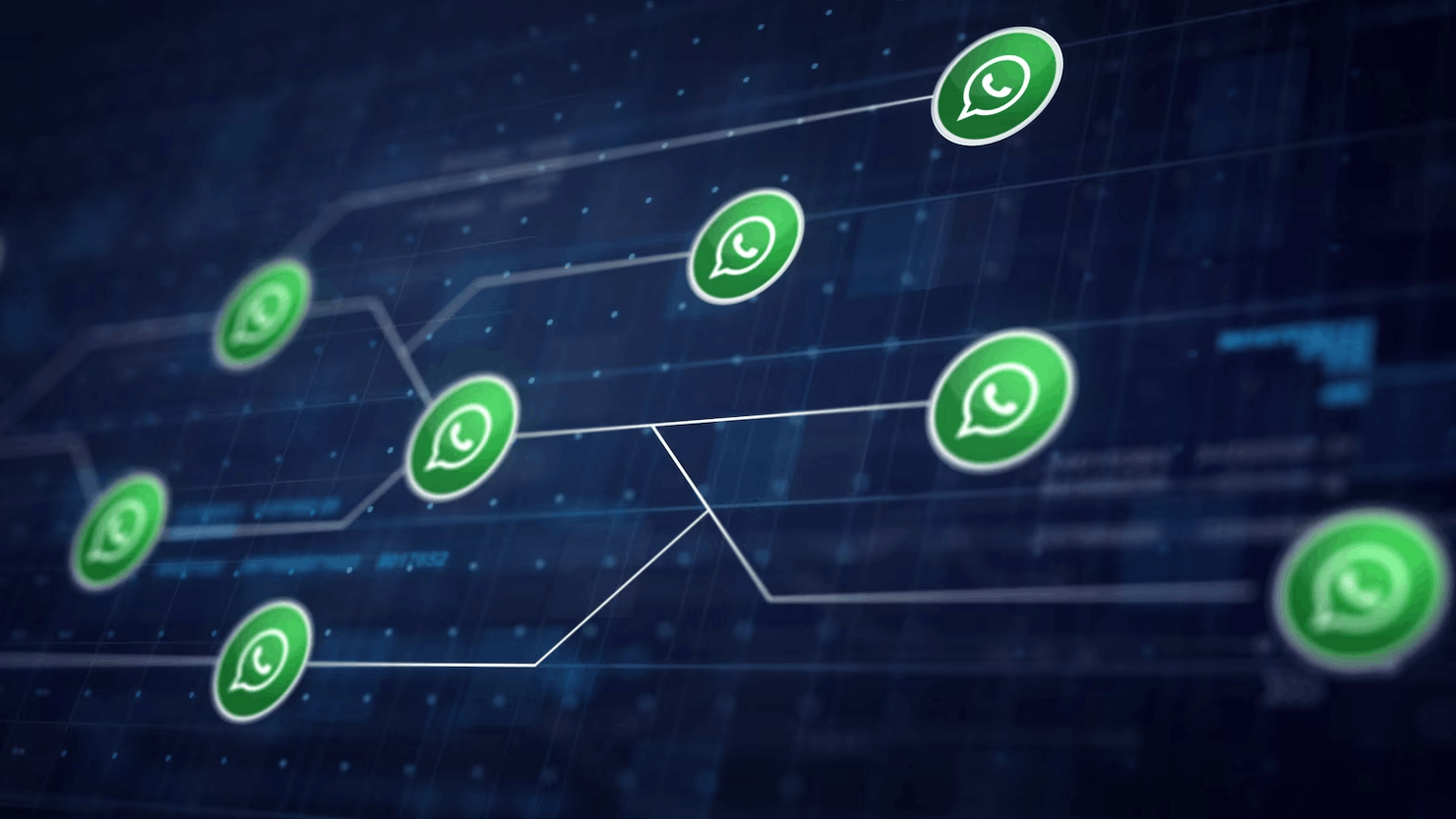Healthcare is changing fast. Patients expect immediate answers, remote care, and simple communication. WhatsApp chatbots are helping clinics and hospitals meet these expectations. They automate tasks, improve response times, and make patient support more accessible.
More than 2 billion people use WhatsApp every month, according to Statista. This makes it one of the most powerful channels for healthcare communication. Hospitals use chatbots to schedule appointments, send reminders, answer FAQs, and even assist with mental health support.
This article explains what a WhatsApp chatbot is, why healthcare providers adopt it, and how you can create one. It also shows real-world examples, tools, and best practices — so you can see what works and avoid common mistakes.

What Is a WhatsApp Chatbot?
A WhatsApp chatbot is a digital assistant that communicates with users via WhatsApp. It uses automation and artificial intelligence to handle messages and tasks that would otherwise require human staff.
In healthcare, this means patients can:
- Book an appointment.
- Receive test results.
- Ask about symptoms or treatment plans.
- Get reminders for medications.
These chatbots rely on WhatsApp Business API, which allows clinics to send structured messages and automate workflows. According to the World Health Organization (WHO), WhatsApp bots played a major role in COVID-19 information delivery, proving how fast and scalable they can be.
Most healthcare chatbots today combine simple scripted responses with AI-powered features. For example, a system might use natural language understanding (NLU) to detect intent or link to a medical knowledge base for symptom triage.
Why Use a WhatsApp Chatbot for Healthcare?
Healthcare systems are under pressure. Staff shortages and rising patient demand make it hard to respond quickly. A WhatsApp chatbot helps close this gap.
- Better Patient Support
Patients expect immediate replies. A chatbot gives them instant responses 24/7. According to a Mayo Clinic study, quick communication increases patient satisfaction and adherence to treatment. - Efficiency and Cost Savings
Routine questions — such as clinic hours or preparation for a lab test — can be automated. This reduces the workload for call centers and allows nurses to focus on clinical care. - Personalized Engagement
Modern bots can access patient data (securely) to tailor responses. For example, they can send medication reminders at specific times or suggest follow-up visits. - Improved Accessibility
WhatsApp is simple to use, even for older adults. It supports text, voice, and file sharing, making healthcare more inclusive.
A well-designed chatbot doesn’t replace medical professionals — it supports them by taking care of administrative communication.

Real-World Examples of WhatsApp Chatbots in Healthcare
Hospitals, insurers, and public health agencies already use WhatsApp chatbots. These examples show how they help manage patient care, improve communication, and reduce administrative load. Adoption is growing because chatbots work well with how patients already communicate daily.
E-Health and Telemedicine
Clinics use WhatsApp chatbots to schedule video consultations and share follow-up instructions. During the pandemic, telehealth demand grew by more than 60%. Many clinics built bots that guided patients from a WhatsApp message directly to a secure video link.
In primary care, this model helps physicians manage chronic patients remotely. The chatbot confirms symptoms, collects daily metrics like blood pressure, and alerts clinicians when readings fall outside normal ranges.
In mental health, bots help with triage before virtual therapy sessions. They gather mood or stress information using structured questions and pass data to the therapist. This saves 10–15 minutes per session and gives clinicians more time for care.
Several digital health startups now integrate AI voice features for accessibility. Using tools like the Graphlogic Text-to-Speech API, they allow elderly or visually impaired users to interact through spoken commands.
Public Health Campaigns
Public agencies use WhatsApp bots to spread verified medical information quickly. The World Health Organization launched its Health Alert chatbot during the COVID-19 pandemic. It reached more than 25 million users worldwide.
The bot answered questions about symptoms, prevention, and vaccination. It operated in over 15 languages and updated content daily as new guidance appeared. This approach reduced the impact of misinformation that circulated on social media.
Several ministries of health followed this model. For example, India’s MyGov Corona Helpdesk handled more than 100 million queries. South Africa and the U.K. launched similar bots to share vaccination site details and check eligibility.
Today, the same architecture supports campaigns on topics such as diabetes prevention, mental health awareness, and maternal care.

Pharmacies and Home Delivery
Pharmacies use WhatsApp chatbots to manage prescriptions and medication delivery. Patients can send a refill request, upload a prescription photo, and get confirmation within minutes.
This service is especially valuable for people with chronic diseases. Instead of waiting on hold or visiting the pharmacy, they receive updates on order status and delivery time directly in WhatsApp.
Some pharmacies integrate payment links, so patients can complete the purchase in one flow. Others use chatbots to remind users about refills based on previous purchase dates.
A 2023 Journal of Medical Internet Research review found that reminder automation reduces medication non-adherence by 15–20%.
Insurance and Claims
Health insurers also benefit from WhatsApp automation. Claim processes are often complex and time-consuming. Chatbots simplify this by letting customers upload documents, verify policy status, and track reimbursement progress.
For example, a patient can send a message: “Check my claim.” The bot replies instantly with the current status and next steps.
Some insurers use AI to classify document types and detect missing information. Others send claim approval notifications automatically. These functions reduce paperwork and speed up processing by several days.
In addition, insurance companies use bots to promote preventive health programs. Users receive short lifestyle tips or reminders about annual checkups.
Hospital Internal Workflows
Several large hospitals now use WhatsApp chatbots internally. Nurses and technicians receive shift updates, inventory alerts, or reminders for equipment maintenance. The bot acts as a coordination tool.
For example, Apollo Hospitals in India introduced a WhatsApp bot that connects departments. It reduced manual phone communication by nearly 40%. Staff receive instant notifications about patient transfers or lab results.
For hospitals, this means fewer errors and faster turnaround times for care delivery.
Example 1: E-Commerce Order Tracking Bot
Although not directly medical, this example helps explain the core automation logic. E-commerce bots manage large volumes of customer queries about orders and returns. The same logic applies in healthcare for managing lab reports, discharge documents, or test results.
A patient might message the clinic’s WhatsApp number and instantly receive:
“Your lab report is ready. Tap the link below to download it securely.”
This small change saves hours of phone calls and reduces administrative load. It also improves patient satisfaction by giving results in real time.
Some labs integrate encryption and verification steps before download, keeping data compliant with HIPAA and GDPR.
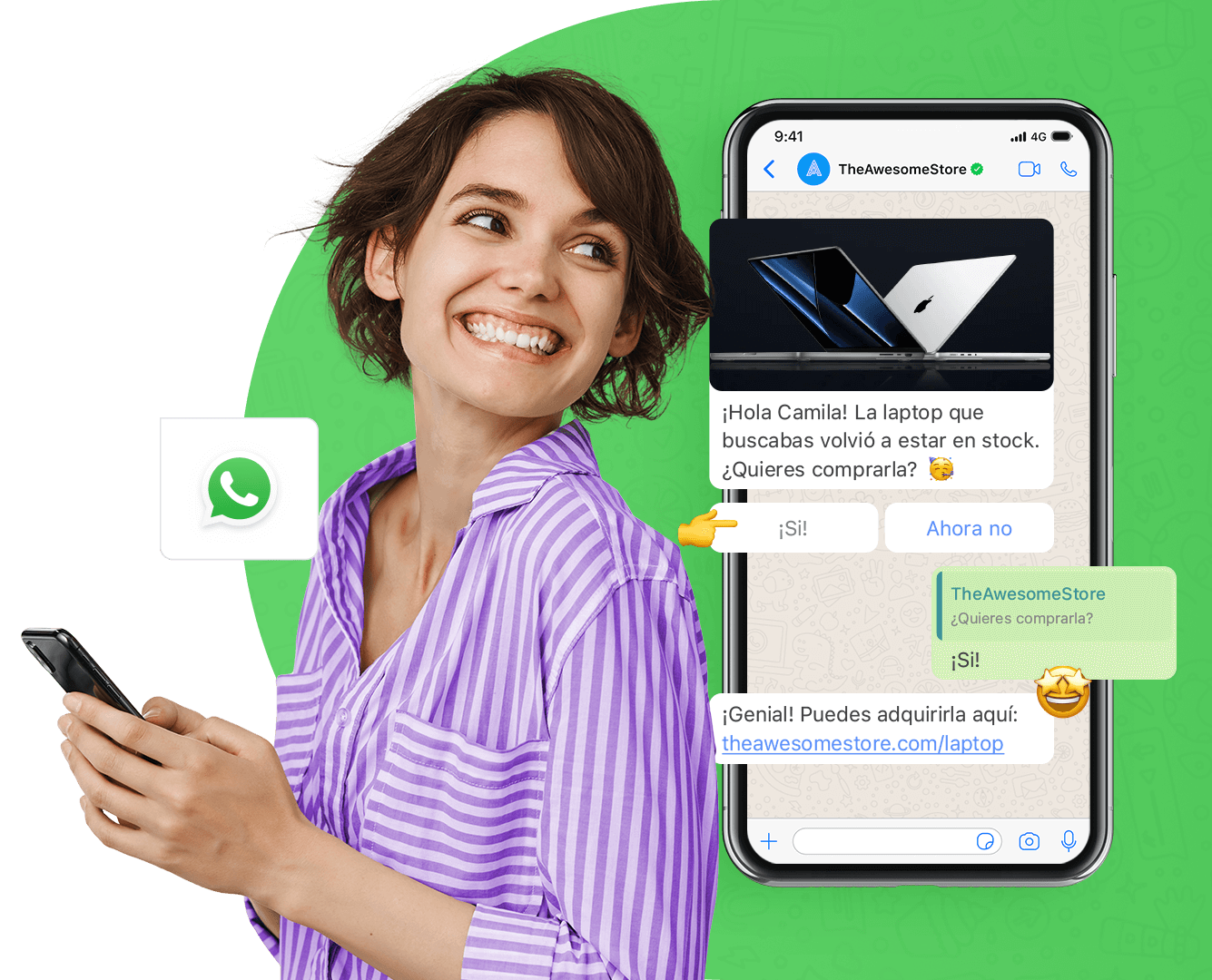
Example 2: Healthcare Appointment Scheduler
Appointment management remains the most common healthcare chatbot use case. Clinics integrate their booking systems with WhatsApp to handle the entire scheduling process.
Patients can ask for available slots, confirm appointments, or reschedule automatically. The chatbot sends reminders 24 hours before the visit and allows cancellations if needed.
A study in JMIR Medical Informatics found that digital appointment tools reduce no-show rates by 20–30%. That improvement has a direct impact on efficiency and revenue.
Modern bots go beyond scheduling. They can triage basic symptoms before booking. For instance, if a user reports chest pain, the bot immediately advises seeking emergency care rather than booking a regular visit.
With integrations like the Graphlogic Generative AI & Conversational Platform, these bots analyze user messages, detect sentiment, and adapt tone. They can recognize frustration or anxiety and respond more empathetically. This makes digital communication feel human and supportive.
Example 3: Post-Discharge and Follow-Up Care
After hospitalization, continuity of care is critical. WhatsApp chatbots now play a key role in monitoring recovery. Patients receive daily check-ins such as:
“How do you feel today on a scale of 1–5?”
Based on the answer, the bot can share guidance or alert a nurse. This reduces readmissions and improves patient safety.
According to a 2022 study in BMC Health Services Research, automated follow-ups lower readmission rates by 12–15 %.
These bots also remind patients about physical therapy sessions or wound care instructions. Because messages arrive in a familiar channel, adherence is high.
Example 4: Vaccination and Preventive Programs
Vaccination campaigns use WhatsApp bots to check eligibility, schedule shots, and send reminders for the next dose. In rural areas, this is often faster than phone outreach.
Bots can deliver localized content, map nearby clinics, and track completed vaccinations securely. Some also include short educational videos about vaccine safety.
The model is expanding to preventive programs for hypertension, smoking cessation, and weight management. Short automated check-ins maintain motivation and accountability.
Example 5: Mental Health and Support Lines
Mental health chatbots on WhatsApp offer anonymous, round-the-clock help. They provide validated self-assessment tools and connect users to therapists when needed.
For instance, a user experiencing anxiety can chat with the bot, which may respond with grounding exercises or breathing techniques. If the answers suggest severe distress, the chatbot can route the user to a helpline.
The National Institute of Mental Health (NIMH) notes that early digital interaction can encourage people to seek help sooner. WhatsApp’s privacy and accessibility make it a natural channel for such support.
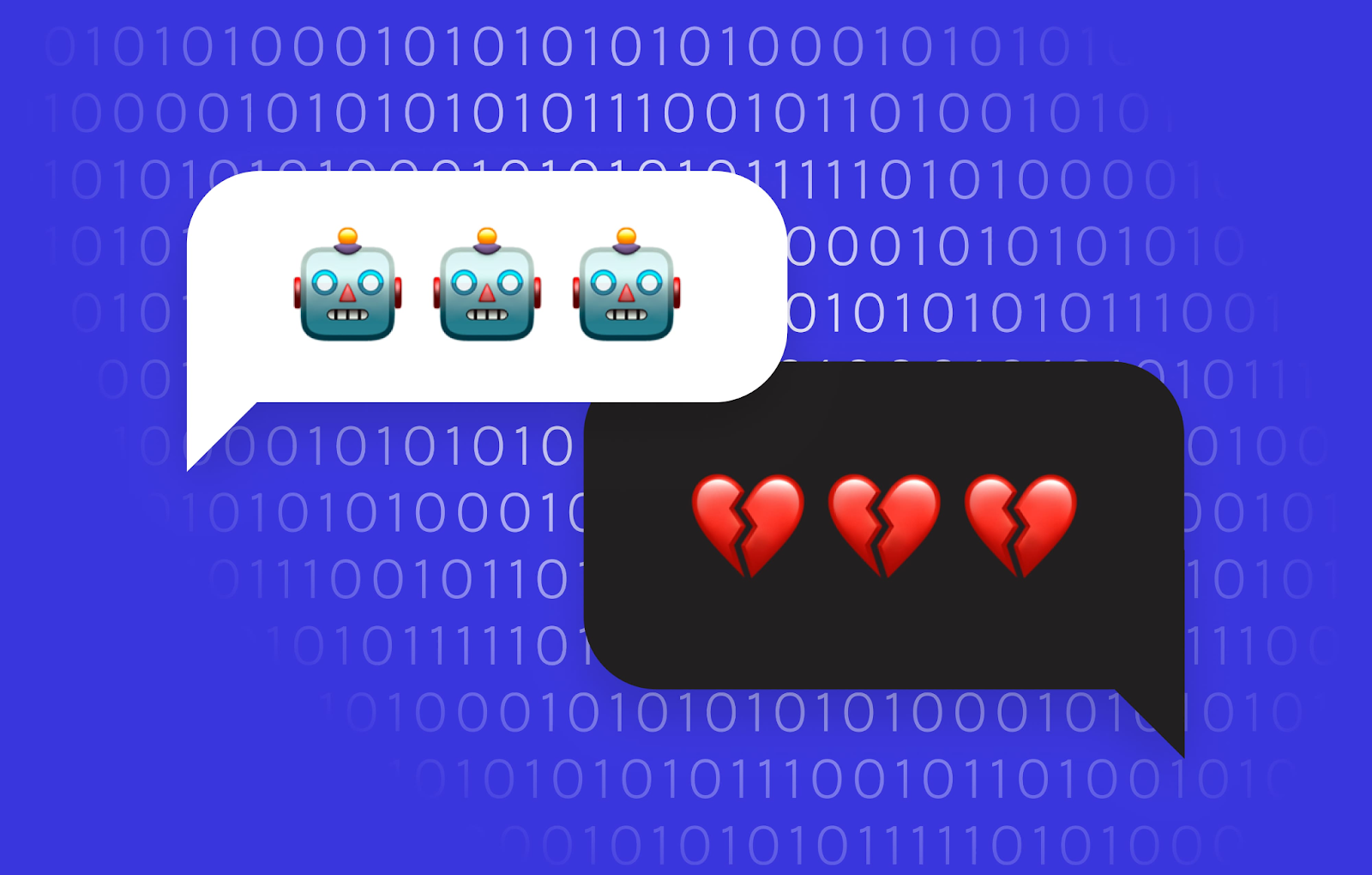
Why These Examples Matter
These real-world cases show that WhatsApp chatbots are not experimental — they are practical tools already reshaping healthcare communication. They bridge gaps between overworked staff and patients who need timely information.
From booking to follow-up, bots streamline the entire patient journey. When combined with AI, they become even more adaptive and empathetic. The key is maintaining clinical oversight and ensuring compliance while using automation for repetitive work.
How to Create a WhatsApp Chatbot: A Step-by-Step Guide
Building a healthcare chatbot for WhatsApp is not as complex as it seems. You need to define goals, select tools, and test before deployment.
Step 1: Define Your Purpose
Decide what the chatbot will do. Start small. A basic bot can manage appointments or FAQs. Later, you can add AI for triage or symptom checks.
Step 2: Choose a Platform
You can build from scratch using APIs or use a ready-made solution. Platforms like Twilio, Wati, and Graphlogic Generative AI & Conversational Platform let you design and deploy bots without deep coding skills.
Step 3: Set Up WhatsApp Business API
Apply through a verified provider. You’ll need a business number, Facebook Business verification, and an approved message template. Once connected, your bot can send notifications or respond to incoming messages.
Step 4: Design Conversational Flows
Plan the dialogue. Each message should be clear, short, and relevant. Use buttons or quick replies when possible.
Step 5: Test and Deploy
Test every scenario. Make sure messages are accurate, and data handling follows HIPAA or local privacy rules.
After testing, monitor real interactions and improve the flow over time.
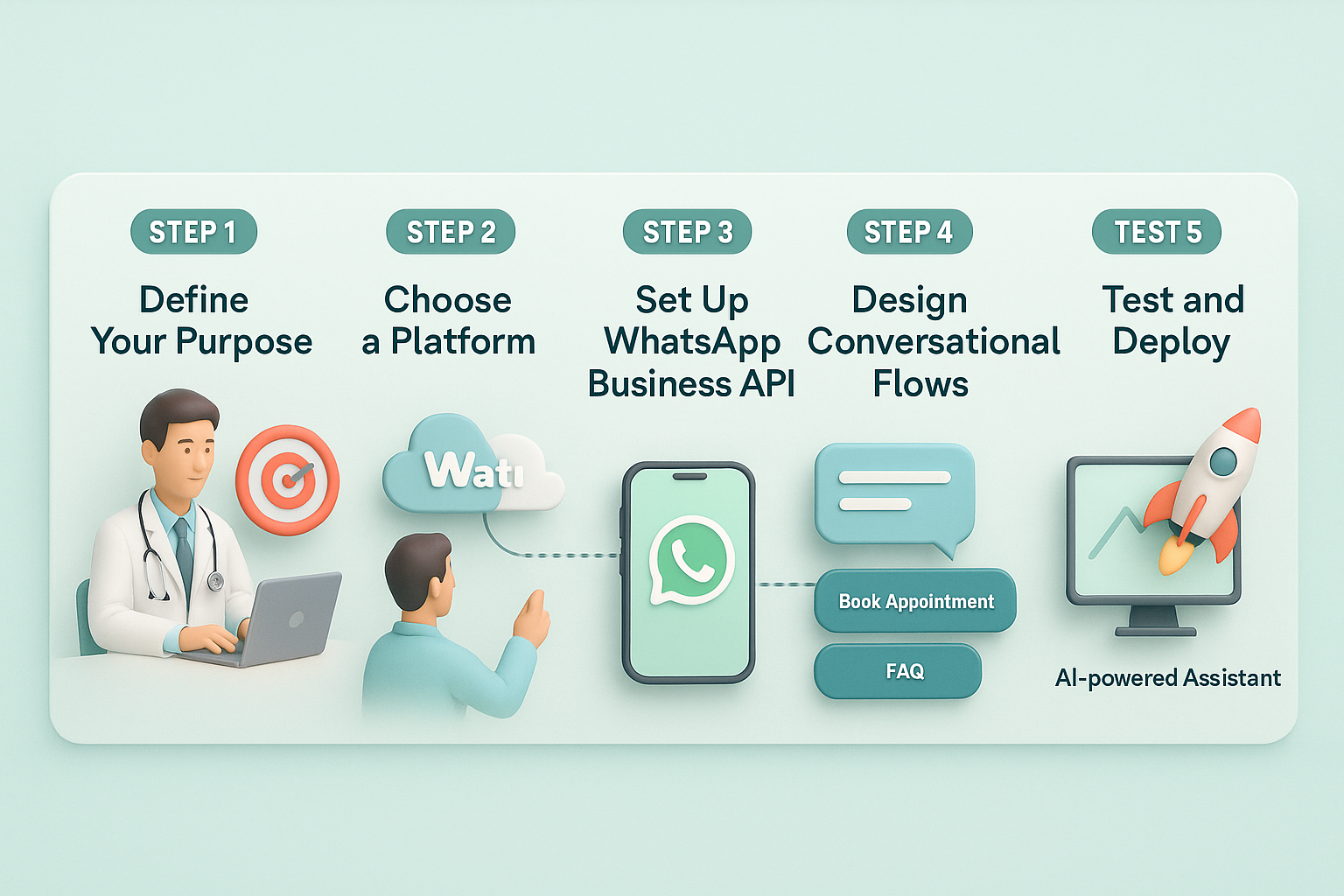
Choosing the Right Platform for Your Bot
Your platform defines how flexible, secure, and scalable the bot will be. The right choice depends on technical needs, data privacy requirements, and how much customization you expect. Healthcare organizations also need reliable uptime, compliance support, and easy integration with existing systems.
Below is a comparison of popular WhatsApp chatbot platforms often used in healthcare projects:
| Platform | Main Features | Best For | Ease of Use | Compliance & Security | Healthcare Example |
| Twilio | Full WhatsApp Business API access, advanced routing, analytics, and automation via REST APIs. | Large hospitals or IT teams that prefer custom code and control. | Moderate – requires developer input. | High – offers encryption, compliance tools, and audit logs. | Used by hospital networks to send secure lab results and alerts. |
| Wati | No-code interface for building bots, contact segmentation, and team inbox. | Mid-size clinics or small healthcare providers. | Easy – drag-and-drop setup. | Moderate – supports verified business accounts. | Used for appointment reminders and patient FAQ automation. |
| Graphlogic | AI-driven conversational design, text-to-speech, speech-to-text, and multimodal chat. | Clinics that need voice-enabled or multilingual bots. | Moderate – AI setup requires initial training but low maintenance. | High – supports encryption and integration with secure APIs. | Used for elderly care communication and chronic patient monitoring. |
| Landbot | Visual drag-and-drop builder, logic branching, and template library. | Basic bots or pilot healthcare projects. | Very easy – visual builder. | Basic – suitable for non-clinical workflows. | Used for public health surveys and feedback collection. |
If your clinic wants natural conversation with voice support, use the Graphlogic Text-to-Speech API. It converts chatbot messages into lifelike speech for accessibility and elderly patients.
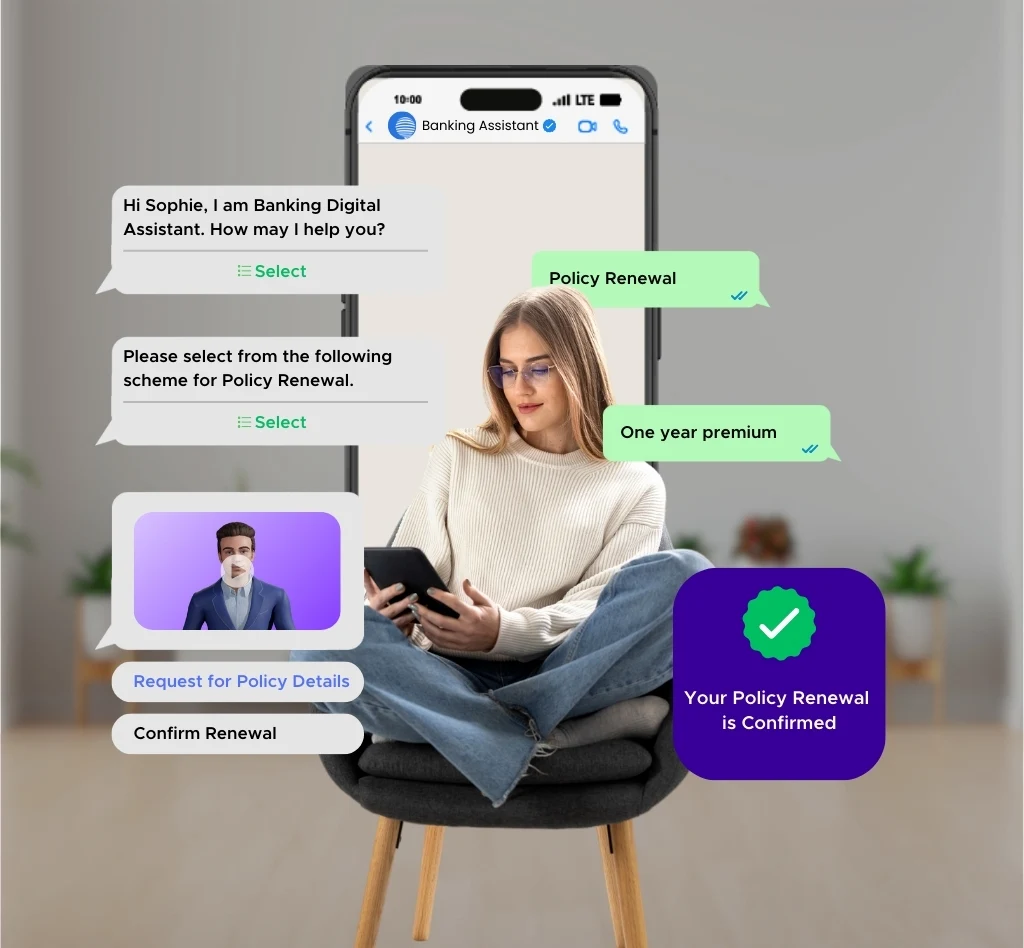
Setting Up WhatsApp Business API
You register your number, verify your business, and connect through a provider. The provider handles message delivery and compliance with WhatsApp’s guidelines.
Healthcare organizations should pay special attention to:
- Data encryption and consent.
- Message templates for sensitive information.
- Response time within 24 hours to maintain trust.
WhatsApp’s own Business Policy outlines these rules clearly.
Designing Conversational Flows
A clear flow ensures patients get the right answers fast. Keep the structure intuitive — one question per message, short replies, and clear options.
Tips:
- Start with a greeting that identifies your clinic.
- Offer 3–5 main options (appointments, results, FAQs).
- Personalize follow-ups using patient name or ID.
- Add fallback responses like “I’m forwarding this to our support team.”
Good flow design saves time for both staff and patients.
Tools and Technologies for Building WhatsApp Chatbots
A healthcare chatbot can combine several tools to deliver intelligent and secure communication.
- Twilio API: Robust infrastructure and analytics.
- Wati: Quick setup and template-based automation.
- Dialogflow: Natural language processing for understanding patient intent.
- Landbot: Visual logic builder for message flow.
- Graphlogic Platform: Combines Generative AI, voice APIs, and retrieval-augmented generation for advanced personalization.
These tools allow clinics to integrate chatbots with electronic health record systems, appointment schedulers, or telehealth platforms.
When combined with voice tools like Graphlogic Text-to-Speech API, a chatbot can even guide visually impaired patients or deliver medication instructions aloud.
Best Practices for WhatsApp Chatbot Development
To create a useful healthcare chatbot, follow some key principles:
- Keep messages concise and conversational.
- Avoid medical jargon unless necessary.
- Use clear action buttons for replies.
- Personalize messages with patient details (safely).
- Update content regularly based on feedback.
Also, provide an option to contact a human at any time. Medical communication should always allow escalation when needed.
The American Medical Association (AMA) recommends hybrid models where AI supports, not replaces, human clinicians.
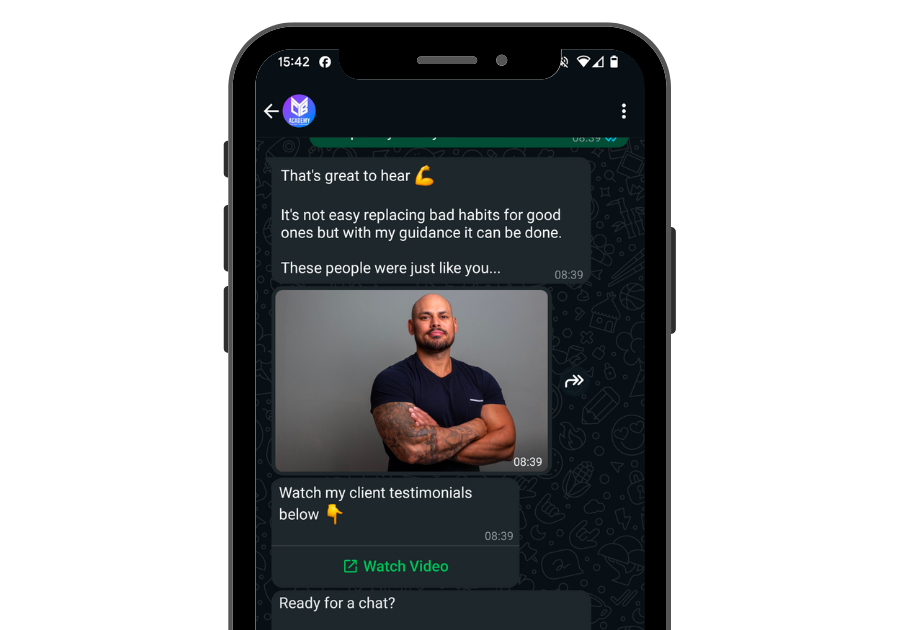
Challenges of Using WhatsApp Chatbots
Healthcare chatbots come with real challenges that must be addressed early.
- Compliance
All communication must respect privacy rules such as HIPAA or GDPR. Sensitive data must be encrypted and stored securely. - Accuracy
AI models can misunderstand patient intent. Incorrect medical advice is unacceptable. Always restrict bots to verified information sources. - Trust and Transparency
Patients must know when they’re talking to a bot. Clear disclosure builds credibility. - Technical Maintenance
API updates or WhatsApp policy changes can break workflows. Continuous monitoring is essential.
The safest way to manage this is by using reliable vendors and conducting regular audits.

The Future of WhatsApp Chatbots in Healthcare
The next generation of healthcare chatbots will be smarter, more connected, and deeply embedded in the digital healthcare ecosystem. As patient expectations evolve, WhatsApp chatbots are set to become not just communication tools, but intelligent care companions that support both patients and providers.
AI and Machine Learning
Advanced AI systems will move beyond simple question-answer models. By analyzing patient history, medical records, and behavioral data, they will be able to predict individual health needs, flag potential risks early, and recommend timely interventions.
Voice and Multimodal Interfaces
The future will also bring greater accessibility and inclusivity. With tools like Graphlogic’s voice APIs, patients — especially those with disabilities or limited digital literacy — will be able to interact with chatbots through speech, images, or gestures, making healthcare communication more human and natural.
Data-Driven Personalization
Chatbots will use accumulated data from previous interactions to deliver personalized care plans, reminders, and lifestyle recommendations. Over time, these systems will learn patient preferences and communication styles, creating a more engaging, continuous care experience.
Interoperability
A key step forward will be seamless integration with Electronic Health Record (EHR) systems, lab platforms, and insurance databases. This interoperability will allow chatbots to provide up-to-date test results, schedule appointments, verify coverage, and even support care coordination between different healthcare providers.
Outlook
According to Deloitte, conversational AI adoption in healthcare is expected to triple by 2026, signaling a shift toward proactive, personalized, and data-driven care. As this transformation unfolds, WhatsApp chatbots will play a crucial role in bridging the gap between patients and digital healthcare services — making care more accessible, efficient, and human-centered.
Key Takeaways About WhatsApp Chatbots
- WhatsApp chatbots are transforming patient communication.
- They improve efficiency, reduce costs, and enhance satisfaction.
- Real-world use shows strong results in scheduling, information delivery, and triage.
- Building one involves clear goals, API setup, and ethical data handling.
- Future chatbots will combine voice, AI, and predictive analytics for better care.
FAQ
A digital assistant that interacts with patients on WhatsApp to automate communication. It handles scheduling, reminders, and answers to routine questions in real time.
Define your use case, select a suitable platform, connect to the WhatsApp Business API, and design the conversation flow. Always test the bot before launch to ensure reliability and compliance.
Popular tools include Twilio, Wati, Dialogflow, Landbot, and Graphlogic’s AI suite. Choose based on your clinic’s size, goals, and privacy requirements.
Appointment schedulers, prescription reminders, symptom checkers, and insurance claim assistants. Some clinics also use bots for post-surgery follow-up and vaccination tracking.
Basic setups can start around $300–500, while advanced AI-based bots may cost several thousand dollars depending on integrations and compliance needs.
